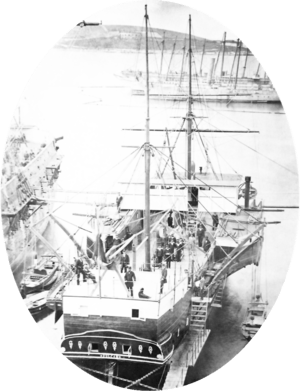SMS Vulcano
SMS Vulcano (subsequently renamed to German Vulkan, also Vulcan) was a paddle steamer[1] built for the Austro-Hungarian Navy in Venice and launched in 1843.[2] Subsequently given the German name Vulkan,[5] or Vulcan.[1] Remained in service until 1872, and finally stricken in 1884 to become a coal hulk.[1]
 SMS Vulcano | |
| History | |
|---|---|
| Name: | Vulcano (renamed Vulkan / Vulcan) |
| Launched: | 1843[1] |
| Fate: | In service until 1872, stricken in 1884 to become a coal hulk[1] |
| General characteristics | |
| Displacement: | 483 metric tons (475 long tons; 532 short tons)[2] |
| Installed power: | 120 ihp (89 kW)[3] |
| Armament: |
|
In 1849 the Vulcano, serving as a balloon carrier (the precursor to the aircraft carrier),[6] launched hot air balloon bombs at Venice, the first offensive use of air power in naval aviation.[4][7][8]
Blockade of Venice
In 1848 Venice rebelled, declaring independence from the Austrian Empire. Vulcano and other Austrian vessels managed to escape capture, however most of their men deserted to the Venetian side, in many cases since non-Italian officers promised immediate discharges to their Italian sailors.[9] In March 1848 Vulcano evacuated the personnel of the Austrian embassy from Naples, but the crew mutinied mid-route and attempted to direct the ship to Venice, however the ambassador Prince Felix of Schwarzenberg managed to restore order and direct the ship to Trieste.[10] [11]
Vulcano was part of squadron commanded by Captain Ludwig Kudriaffsky that blockaded Venice in April 1848.[9] On 26 April 1848 the Vulcano (armed with two 48-pounders and four 12-pounders) intercepted a Greek brig attempting to break the blockade, but was engaged in a gun battle with the Venetian Pio Nono (armed with an 80-pounder Paixhan and a 24-pounder) who hit the Vulcano twice forcing her to withdraw.[3]
Balloon bombardment
In July 1849 Vulcano took part in the first aggressive use of balloons in warfare,[12][13] serving as a balloon carrier (the precursor to the aircraft carrier)[6] in the first offensive use of air power in naval aviation.[4][7][8] Austrian forces besieging Venice attempted to float some 200 paper hot air balloons, each carrying a 24- to 30-pound bomb that was to be dropped from the balloon with a time fuse over the besieged city. The balloons were launched mainly from land; however, some were also launched from Vulcano. The Austrians used smaller pilot balloons to determine the correct fuse settings. At least one bomb fell in the city; however, due to the wind changing after launch, most of the balloons missed their target, and some drifted back over Austrian lines and the launching ship Vulcano.[14][15][16] On 4 July, she had run aground at Malamocco and come under fire from Manfrin Fort. A crew member was killed. She was damaged at her paddlebox. Vulcan was refloated the next day with assistance from SMS Custoza and the Austrian steamships Curtatone and Dorotea.[17]
Subsequent Service
On 17 November 1869, was one of seventy ships, all of which drew less than 13 feet of water, that sailed through the Suez Canal in a procession marking the opening of the canal.[18]
Remained in service until 1872, and finally struck in 1884 to become a coal hulk.[1]
References
- The Influence of Air Power Upon History, Walter J. Boyne, page 409
- To Ascend from a Floating Base: Shipboard Aeronautics and Aviation, 1783-1914, R. D. Layman, page 34
- VENICE THE CITY OF THE SEA, Edmund Flagg, pages 242-243, 254, 451
- Taking Flight: Inventing the Aerial Age, from Antiquity through the First World War, Richard P. Hallion, page 66
- In the Service of the Emperor: Italians in the Austrian Armed Forces, 1814-1918, Lawrence Sondhaus, page 87
- Naval Aviation in the Second World War, Philip Kaplan
- Naval Aviation in the First World War: Its Impact and Influence, R. D. Layman, page 56
- Broken Wings: The Hungarian Air Force, 1918-45, Stephen L. Renner, page 2
- Naval Warfare, 1815-1914, Lawrence Sondhaus, page 46
- Sondhaus, Lawrence. "Prince Felix zu Schwarzenberg and Italy." Austrian History Yearbook 22 (1991): 57-75.
- In the Service of the Emperor: Italians in the Austrian Armed Forces, 1814-1918, Lawrence Sondhaus, page 85
- Air Power in the Age of Total War, John Buckley
- The Future of Drone Use: Opportunities and Threats from Ethical and Legal Perspectives, Asser Press - Springer, chapter by Alan McKenna, page 355
- Military Aircraft, Origins to 1918: An Illustrated History of Their Impact, Justin D. Murphy, page 9-10
- Military Ballooning During the Early Civil War, The Johns Hopkins University Press, F. Stansbury Haydon, page 18-20
- Mikesh, Robert C. "Japan's World War II balloon bomb attacks on North America." (1973).
- "Vienna, July 10". Daily News (979). London. 16 July 1849.
- Archives of Empire: Volume I. From The East India Company to the Suez Canal, edited by Barbara Harlow, Mia Carter, page 568